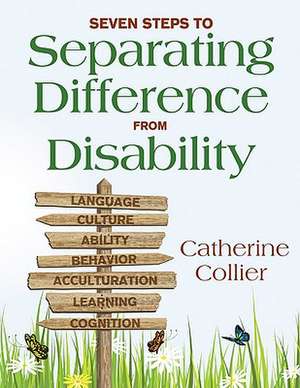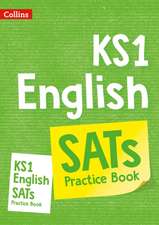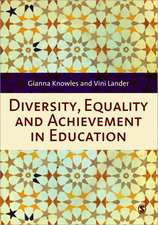Seven Steps to Separating Difference From Disability
Autor Catherine C. Collieren Limba Engleză Paperback – 29 dec 2010
- A 7-step process for separating difference from disability within an RTI framework
- Resource materials for implementing the process
- Reproducible forms
- Recommended reading materials
- Case studies
- Self-study assessment worksheet
- Glossary.
Preț: 298.36 lei
Nou
57.11€ • 62.05$ • 48.00£
Carte tipărită la comandă
Livrare economică 21 aprilie-05 mai
Specificații
ISBN-10: 1412971608
Pagini: 176
Dimensiuni: 216 x 279 x 13 mm
Greutate: 0.5 kg
Ediția:1
Editura: SAGE Publications
Colecția Corwin
Locul publicării:Thousand Oaks, United States
Recenzii
“This book is timely and an important resource for all schools with diverse populations to have in their professional libraries and in their Child Study Team rooms. This book would also be a complete text to use in an ESOL certification class devoted to planning interventions for students of concern.”
“This is a complete guide for practitioners. I would be able to pick up the book and determine my child's stage in the study team process and where we should go next. Each step in the book stands alone as a reference.”
“This book offers a detailed, easy-to-follow approach to determining the needs of students who are having difficulty learning, including assessments and interventions. I am putting the knowledge I obtained to good use, and will continue to use it as a reference."
Cuprins
Introduction
1. Building and Sustaining a Foundation for Learning
Our Diverse Students
Enculturation and the CLD Student
Enculturation
José Case Study
2. Establishing and Supporting Resiliency
Cognition and Language
A Brief Review of Language Acquisition Issues
Cognitive Learning Style
José Case Study
3. Instructional Intervention and Differentiated Instruction
Culture and Language
Cognitive Learning Style
Experience
Sociolinguistic Development
Acculturation
José Case Study
4. Intensive Intervention and Progress Monitoring
Asking the Right Questions
How to Use the Information
José Case Study
5. Resolution or Referral
Testing
Adaptation of Assessments
José Case Study
6. Integrated Services
Bias in Service Plans
Emotional and Behavioral Disorders
Intellectual Exceptionalities
Learning Disabilities
Integrating Special Needs and CLD Needs
José Case Study
7. Maintaining and Sustaining CLDE Programs
Service Options
Teacher Preparation
Specific Skills and Competencies for Teachers
José Case Study
Conclusion
Glossary
References
Index
Notă biografică
Learn more about Catherine Collier¿s PD offerings
Catherine Collier, Ph.D. has over 45 years experience in equity, cross-cultural, bilingual, and special education. Dr. Collier is a nationally recognized expert on diverse learners with learning and behavior needs. She established and directed the Chinle Valley School, Dine Bitsiis Baa Aha Yaa, bilingual services for Navajo students with severe and multiple disabilities for the Navajo Nation. She was the director of a teacher-training program, Ikayurikiit Unatet for the University of Alaska for seven years, preparing Yup¿ik Eskimo paraprofessionals for certification as bilingual preschool, elementary, and special educators. She was an itinerant (diagnostician/special education) for Child Find in remote villages in Alaska. For eight years, Dr. Collier worked with the BUENO Center for Multicultural Education, Research, and Evaluation at the University of Colorado, Boulder, where she created and directed the Bilingual Special Education Curriculum/Training project (BISECT), a nationally recognized effort. She is active in social justice activities for culturally and linguistically diverse learners and families. She started the first bilingual special education programs for the Navajo Nation and the White Mountain Apache. She is currently the director of the national professional development project Curriculum Integration for Responsive, Crosscultural, Language Education (CIRCLE) at Western Washington University. She works extensively with school districts on professional and program development for at-risk diverse learners. Dr. Collier provides technical assistance to university, local, and state departments of education regarding programs serving at-risk cognitively, culturally and linguistically diverse learners. She works with national organizations to provide professional development in the intersection of crosscultural, multilingual, diversity, special needs issues in education.









